|
 Bolbitius muscicola Bolbitius muscicola
SynonymsPluteolus muscicola
Pluteus muscicola
BiostatusPresent in region - Indigenous. Endemic
Images (click to enlarge)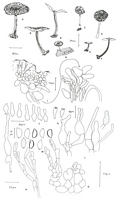
Caption: A. Basidioma with section (B) Taylor 665. C. Basidioma with section (D) Taylor 84. E. Basidioma with section (F) Taylor 342. G-l Taylor 665, G. Basidioma with section (H); I. LS Pileipellis continuing in I'. J-O Taylor 1322, J. Cheilocystidia; K. | 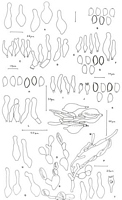
Caption: (holotype), A. Cheilocystidia; H. Basidiospores, B-D Horak 67/112, B. Basidiospores; C. Cheilocystidia; D. Caulocystidia. E-G Horak 67/46, E. Cheilocystidia; F. Caulocystidia; G. Basidiospores. I-M Horak 68/690, I. Cheilocystidia; J. Basidia; K. Basidios | 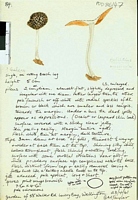
Caption: Watercolour
Owner: G.M. Taylor | 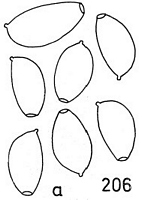
Caption: 206-Pluteolus muscicola: a. spores. | 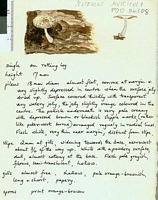
Caption: Watercolour
Owner: G.M. Taylor | 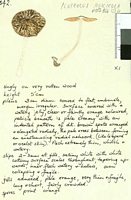
Caption: Watercolour
Owner: G.M. Taylor | 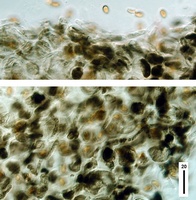
Caption: cap cells showing mixture of spherical and cylindrical.
Owner: J.A. Cooper | 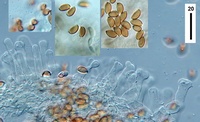
Caption: cheilocystidia and spores.
Owner: J.A. Cooper | 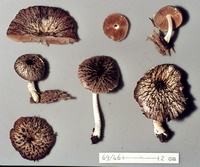
Caption: ZT69-046
Owner: E. Horak: © Creative Commons Attribution-Noncommercial 3.0 New Zealand | 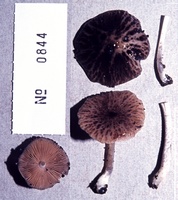
Caption: ZT0844
Owner: E. Horak: © Creative Commons Attribution-Noncommercial 3.0 New Zealand | 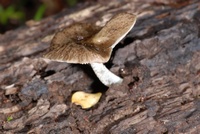
Owner: J.A. Cooper | 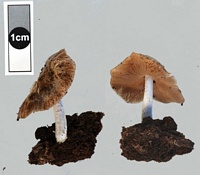
Owner: J.A. Cooper | 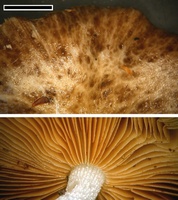
Caption: scale=5mm. Details of stem and cap.
Owner: J.A. Cooper | 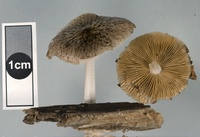
Owner: J.A. Cooper | 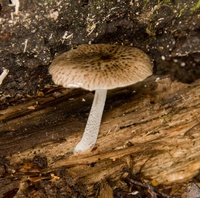
Owner: J.A. Cooper | 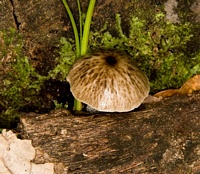
Owner: J.A. Cooper | 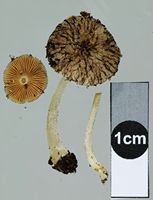
Owner: J.A. Cooper | 
Caption: Plate 2: 2, Pluteus muscicola, x 1 ;2a, spores, x 2000
Owner: PDD | 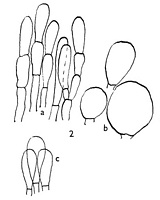
Caption: Fig 1: 2, P. muscicola colourless hyphal endings of cuticle, X 1000; 2b, inflated pigmented cells, x 1000; 2c, cystidia of gill-edge, x 1000
Owner: PDD |
Article: Watling, R.; Taylor, G.M. (1987). Observations on the Bolbitiaceae: 27. Preliminary account of the Bolbitiaceae of New Zealand. Bibliotheca Mycologica 117: 61 p. + 17 pl.
Description: Pileus 18-50 mm, membranaceous, convex soon plano-convex or plane, sometimes umbonate at first, then depressed, very thin and delicate, thick-gelatinous then glutinous from clear or faintly sienna, watery jelly, whitish, pale buff, vinaceous buff or smoke grey beneath gluten with radially arranged, dark brown or black depressions, smaller and less conspicuous towards substriate margin, and paler areas between forming an anastomosing network; in some specimens the resulting pattern resembling a leopard skin. Stipe 17-50 x 2-3 mm, cylindric or slightly swollen towards base, narrowest at centre, brittle, white, pruinose throughout or only at apex, and then appressed fibrillose below, base sometimes tomentose, hollow. Gills almost free or adnexed, pale orange brownish then with rust tinge, papery, very thin and fragile, fairly crowded with fimbriate, paler edges. Flesh extremely thin in pileus, whitish or watery, very translucent near pileus-margin, silky fibrous in stipe, yellowish towards stipe-base. Smell none.
Basidiospores orange-tawny in mass, 7.5-8.5(-9.5) x 4.5-5.5(-6) µm ellipsoid, very slightly amygdaliform in side-view, smooth, relatively thick-walled, truncate from broad germ-pore. Basidia 4-spored, clavate-pedicellate, hyaline, in 'pavement' with shorter
brachycystidia. Cheilocystidia lageniform with short to elongate neck, 17.5-35 x 6-10.5(-12) µm, apex slightly swollen 2.5-5(-7) µm; pleurocystidia absent. Pileipellis a mixture of chains of inflated cells, 14-22.5 µm long, and vesiculose to spheropedunculate cells, 29-40 x 15-26 µm, some end-cells filled with pale greyish to lilaceous brown vacuolar sap, long, flexuous, septate hyphae also present pushing through gelatinous pellicle.
Notes: The spotting, pattern of raised lines and scrobiculae of the pileus and their colouring is very variable, and probably depends on age of the basidioma and environmental conditions, although the microscopic characters are relatively constant. However, a collection on Nothofagus fusca (Horak ZT 67/192) differed in the cheilocystidia being slightly forked at their apex, the basidiospores slightly paler in overall pigmentation and slightly smaller, and the pileipellis apparently lacking numerous elongate hyphae. The collection, however, comes well within the variation accepted for B. muscicola.
Horak (1971b) agrees with our disposition of Stevenson's taxon although he prefers to use the generic name Pluteolus. Stevenson's material differs only in that a few 2-spored basidia were found; this undoubtedly explains the slightly larger spore-size for the type material; also see Stevenson, 1982a. ZT 69/46 is somewhat different in that although the immature pilei are scrobiculate the old pilei have dark raised lines upon them.
Article: Horak, E. (1971). A contribution towards the revision of the Agaricales (Fungi) from New Zealand. New Zealand Journal of Botany 9(3): 403-462 (http://www.rsnz.org/publish/abstracts.php).
Description: Pluteus muscicola Stevenson (26 D) Fig. 17 = Pluteolus muscicola (Stevenson)
comb. nov. (Basionym: P. muscicola Stevenson, Kew Bull. 16: 72, 1962)
Spores elliptic, rust: brown to ochraceous, smooth, with broad apical germ pore,
8-11 X 4.5-5.5 µ. Cuticle of articulate cells forming an hymeniderm, with brown
plasmatic pigment, clamp connections none.
Article: Stevenson, G. (1962). The Agaricales of New Zealand: II. Kew Bulletin 16(1): 65–74.
Description: Pileus 2-5 cm. diam., nearly plane, glutinous, fawn coloured with brown pitlike markings under the gluten, minutely striate at edge. Gills free, very crowded, fawn becoming dark-pink. Stipe 3 cm. x 2-5 mm. tapering upwards, white with silky floccose scales. Spores 5 x 811, somewhat thick walled, print pink. Cuticle consisting of colourless hyphal endings with patches of inflated cells containing brown pigment.
Habitat: rooting amongst mosses, Levin, 18.6.1949, Stevenson.
|